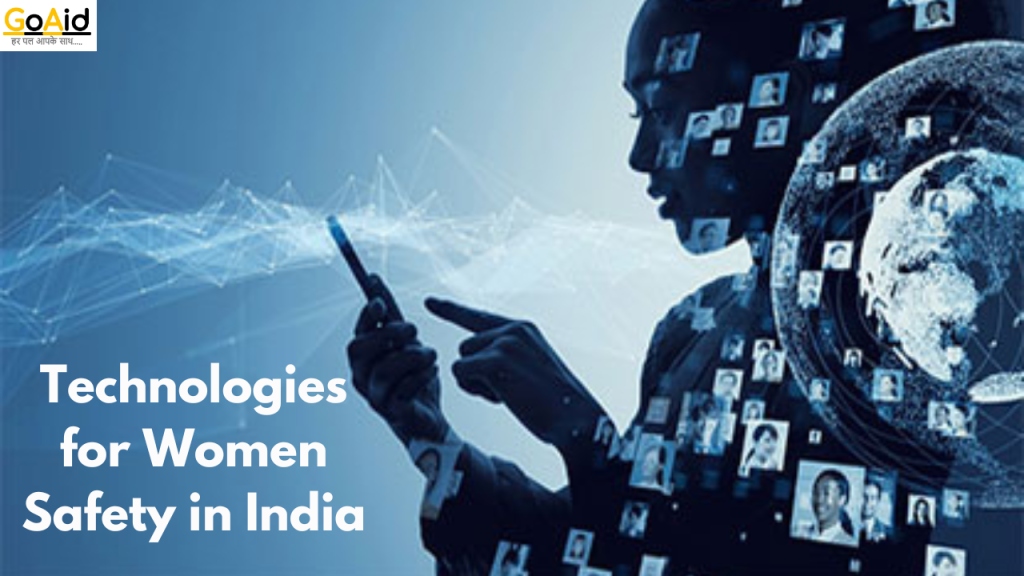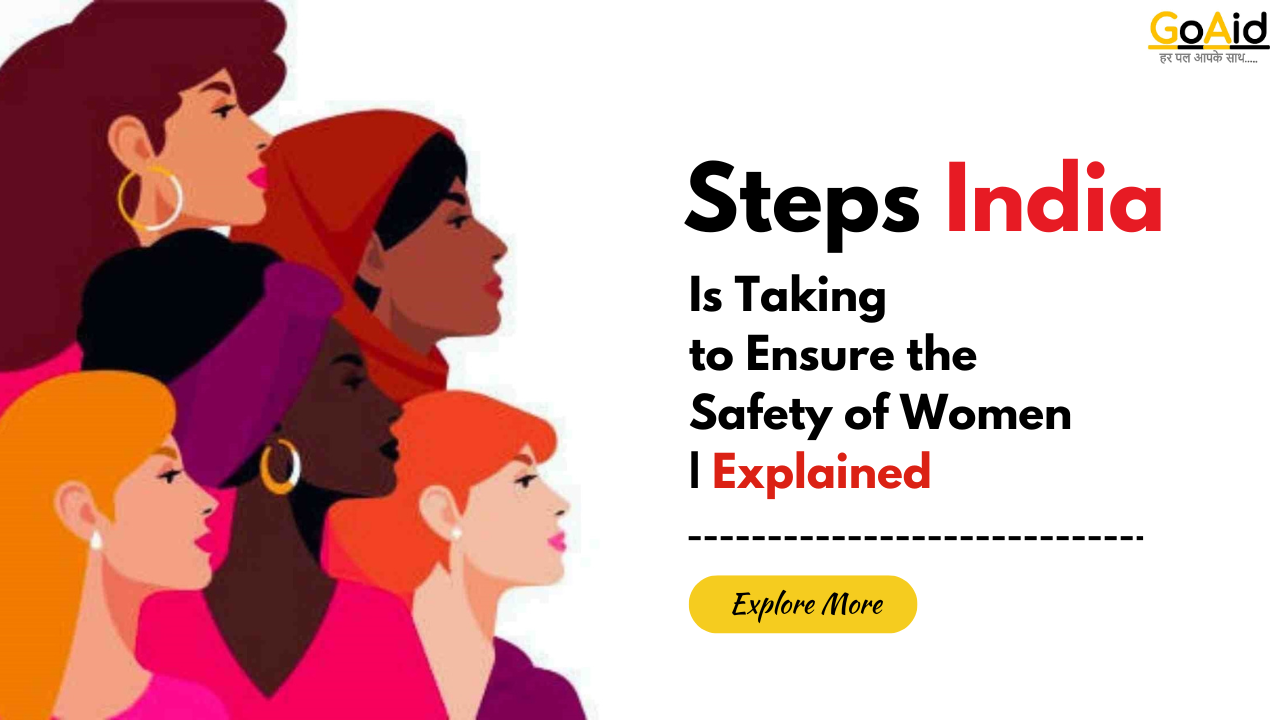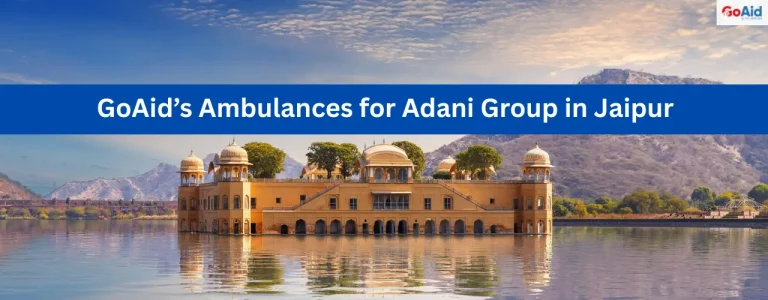India is growing, but there is no mean of this growth if half of the Indian Population not feel safe. Well, this is not the case here. For the last 75 years, India has done good to ensure Women safety in India.
Now you must be thinking that every day in the newspaper, we read about crime against women, then how can we ensure women’s safety in India? When critics say that ŌĆśWomen Are not Safe in IndiaŌĆÖ, is it correct? We need to know the answer to this widespread question.
This is why, in this blog, we have added complete details about Women’s Safety in India including recent stats, Freedom of Women, Laws in India for women, Women Helpline Number, government steps to ensure the safety of Women in India, and so on. If you are excited to know about all these details then read this blog to the end & donŌĆÖt forget to express your thoughts on Women Safety in India.
So, letŌĆÖs start:
Details about WomenŌĆÖs Safety in India
In India, ensuring women’s safety remains a critical challenge despite ongoing efforts to address gender-based violence and discrimination. Here are some crucial statistics highlighting the scenario of women’s safety in India:
- Violence Against Women: According to the National Crime Records Bureau (NCRB), there were over 4 lakh cases of crimes against women reported in 2019, including incidents of rape, dowry deaths, domestic violence, and harassment.
- Sexual Assault: India has seen a significant increase in reported cases of sexual assault against women. NCRB data shows that in 2019, there were over 32,000 reported cases of rape, with many more incidents believed to go unreported due to social stigma and fear of reprisal.
- Domestic Violence: Domestic violence remains widespread, affecting women across all socio-economic backgrounds. A survey conducted by the National Family Health Survey (NFHS) found that around one-third of women in India have experienced physical or sexual violence by their intimate partners.
- Acid Attacks: India has one of the highest rates of acid attacks in the world. These attacks often result in severe physical and psychological trauma for the victims, with long-term consequences on their well-being and livelihoods.
- Child Marriage: Despite legal restrictions, child marriage continues to be prevalent in many parts of India. According to UNICEF, around 27% of girls in India are married before the age of 18, exposing them to higher risks of violence and exploitation.
- Human Trafficking: India is a source, transit, and destination country for human trafficking, with women and girls disproportionately affected. They are trafficked for various purposes, including forced labor, sexual exploitation, and domestic servitude.
- Access to Justice: Women often face significant barriers in accessing justice and seeking redress for violations of their rights. Factors such as lack of legal awareness, inadequate support services, and lengthy judicial processes contribute to low conviction rates for crimes against women.
Read More: Free Ambulance Service for Pregnant Women in India
Crimes Against Women in India
In India, ensuring women’s safety remains a critical challenge despite ongoing efforts to address gender-based violence and discrimination. Recent statistics paint a grim reality of the situation:
Recent Stats on Women’s Safety in India (as of May 15, 2024)
- High Crime Rates: According to the National Crime Records Bureau (NCRB) 2022 report, a staggering 4,45,256 cases of crimes against women were registered in India, translating to roughly 51 cases every hour [Times of India]. This signifies a concerning upward trend compared to previous years.
- Increased Vulnerability: The NCRB data also shows a rise in the crime rate per 100,000 women population, jumping from 58.8 in 2018 to 66.4 in 2022 [Deccan Herald].
- Sense of Fear: A report by the Georgetown Institute for Women, Peace and Security paints a worrying picture. India ranked a low 128th out of 177 countries in the 2023 Women Peace and Security Index, indicating a decline in women’s perceived safety [India Today].
Types of Crimes
- Domestic Violence: The NCRB report reveals that cruelty by husbands or relatives accounts for the majority of crimes against women (31.4%) [Times of India].
- Sexual Assault: Rape constitutes 7.1% of reported crimes, highlighting the vulnerability women face [Times of India].
- Other Crimes: Kidnapping and abduction (19.2%), and assault with intent to outrage modesty (18.7%) are other prevalent crimes faced by women [Times of India].
Also Read: Common Causes of Ambulance Delays in India
Freedom of Women in India
India presents a fascinating yet complex picture when it comes to freedom for women. While legal frameworks exist to guarantee equality, social realities paint a different story. Let’s delve into the current landscape with some key statistics:
Education and Employment:
- Literacy Gap: Though female literacy rates have risen significantly, only 50% of Indian women are literate compared to 65.5% of men [UNDP]. This disparity limits their access to education and career opportunities.
- Workforce Participation: Despite a large number of women contributing to the workforce, the female labor force participation rate stands at a mere 23% [Wikipedia]. This statistic likely underestimates women’s contribution, particularly in the informal sector.
Social Freedom:
- Urban vs. Rural Divide: A significant disparity exists between urban and rural India. In 2021, only 14.4% of seats in parliament were held by women, reflecting a lack of representation, particularly from rural areas [UN Women].
- Early Marriage: 27.3% of women aged 20-24 were married before 18, highlighting the social pressures surrounding marriage and limiting educational and career choices [UN Women].
Safety and Security:
- Crime Rates: A grim reality – NCRB data from 2022 reveals a staggering 4,45,256 cases of crimes against women registered in India, translating to roughly 51 cases every hour [Times of India]. This pervasive fear significantly impacts their sense of freedom.
Signs of Progress:
- Legislative Efforts: The enactment of the Criminal Law (Amendment) Acts of 2013 and 2018 strengthened legal frameworks to address violence against women [Press Information Bureau].
- Women’s Movements: Feminist movements and activism are gaining momentum, raising awareness about gender equality and advocating for women’s rights.
Know More: What are the rules and Regulations of ambulance in India?
Why Safety of Women in India Important?
We have added the Top-10 reasons highlighting the importance of women’s safety in India:
- Human Rights: Ensuring the safety of women is a fundamental human right. Every individual, regardless of gender, deserves to live free from the threat of violence and discrimination.
- Gender Equality: Women’s safety is essential for achieving gender equality. When women feel safe in their homes, workplaces, and communities, they can fully participate in social, economic, and political life.
- Public Health: Violence against women has significant public health implications. It can lead to physical injuries, mental health disorders, and other long-term health consequences, affecting not only individual women but also their families and communities.
- Economic Development: Women’s safety is closely linked to economic development. When women feel safe, they are more likely to pursue education, seek employment, and contribute to economic growth, benefiting society as a whole.
- Family Well-being: Women often play a central role in caregiving and nurturing families. Ensuring their safety creates a stable and supportive environment for families to thrive and children to grow up healthy and happy.
- Preventing Gender-based Violence: Safety measures for women help prevent gender-based violence, including domestic violence, sexual harassment, and trafficking. By addressing the root causes of violence, society can create safer communities for all.
- Legal Rights: Protecting women’s safety reinforces their legal rights and access to justice. It promotes accountability for perpetrators of violence and ensures that women have avenues to seek redress for violations of their rights.
- Education and Empowerment: Safe environments empower women to pursue education, develop skills, and make informed choices about their lives. When women are safe, they can unlock their full potential and contribute positively to society.
- Social Cohesion: Women’s safety fosters social cohesion and trust within communities. When women feel secure, they are more likely to engage in community activities, build social networks, and support each other, strengthening community bonds.
- National Progress: Women’s safety is integral to the overall progress and development of the nation. It reflects a society’s commitment to justice, equality, and human dignity, shaping its reputation and standing on the global stage.
Also read: The Ambulances in India ŌĆō Types and Uses
Laws in India that Ensure the Safety of Women
We have enlisted the Top 20 Laws for Women in India:
- The Protection of Women from Domestic Violence Act, of 2005: Provides legal protection to women from domestic violence and abuse, including physical, emotional, sexual, and economic abuse.
- The Sexual Harassment of Women at Workplace (Prevention, Prohibition, and Redressal) Act, 2013: Mandates the prevention and redressal of sexual harassment of women at workplaces, ensuring a safe and conducive work environment.
- The Dowry Prohibition Act, 1961: Prohibits the giving or receiving of dowry in marriage, aiming to prevent dowry-related violence and exploitation of women.
- The Indecent Representation of Women (Prohibition) Act, of 1986: Prohibits the depiction of women in a derogatory or indecent manner in advertisements, publications, or any form of media.
- The Prohibition of Child Marriage Act, 2006: Prohibits the solemnization of child marriages and provides for the protection and welfare of children, especially young girls, from early marriage.
- The Maternity Benefit Act, 1961: Ensures maternity benefits for women, including paid maternity leave, prenatal and postnatal care, and other maternity-related benefits.
- The Medical Termination of Pregnancy Act, 1971: Regulates the termination of pregnancies to safeguard the health and well-being of women and prevent unsafe abortions.
- The Immoral Traffic (Prevention) Act, of 1956: Addresses the trafficking of women and girls for prostitution and other forms of sexual exploitation, providing for preventive and punitive measures against trafficking offenders.
- The Prohibition of Child Marriage Act, of 2006: Seeks to prevent the solemnization of child marriages and provides for the protection and welfare of children, especially young girls, from early marriage.
- The Juvenile Justice (Care and Protection of Children) Act, 2015: Protects the rights of women and children, including victims of sexual abuse and exploitation, and ensures their rehabilitation and reintegration into society.
- The Protection of Children from Sexual Offences (POCSO) Act, 2012: Provides for the protection of children from sexual offenses, including sexual assault, harassment, and exploitation, and ensures speedy investigation and trial of such cases.
- The Prohibition of Trafficking of Persons Act, 2018: Addresses trafficking in persons, including women and children, for various forms of exploitation, such as forced labor, sexual exploitation, and organ trafficking.
- The Equal Remuneration Act, 1976: Ensures equal pay for equal work for men and women, prohibiting discrimination on the basis of gender in matters of wages and employment.
- The National Commission for Women Act, 1990: Establishes the National Commission for Women (NCW) to safeguard and promote the rights and interests of women, including investigating complaints of gender-based discrimination and violence.
- The Pre-Conception and Pre-Natal Diagnostic Techniques (PCPNDT) Act, 1994: Prohibits sex determination and selective abortion of female fetuses, aiming to prevent gender-based sex selection and skewed sex ratios.
- The Hindu Succession Act, of 1956: Provides for equal inheritance rights for women in Hindu Undivided Families, ensuring that daughters have equal rights to ancestral property.
- The Muslim Women (Protection of Rights on Marriage) Act, 2019: Criminalizes the practice of triple talaq (instant divorce) and provides penalties for offenders, safeguarding the rights and dignity of Muslim women.
- The Criminal Law (Amendment) Act, 2013: Introduces amendments to the Indian Penal Code (IPC), the Code of Criminal Procedure (CrPC), and the Indian Evidence Act to enhance punishment for sexual offenses and improve legal procedures for investigating and prosecuting such crimes.
- The Domestic Violence Rules, 2006: Provide guidelines for the implementation of the Protection of Women from Domestic Violence Act, 2005, including procedures for filing complaints, obtaining protection orders, and accessing support services.
- The Maternity Benefit Act, 1961: This law provides for maternity leave and other benefits for women employees, promoting the health and well-being of pregnant and nursing mothers in the workforce.
Read More: How To Book Ambulance Service in India
Women Helpline Number in India ŌĆō State-wise
We have enlisted the Women Helpline number of each state of India in the table below:
| State | Women Helpline Number in each States |
| Andhra Pradesh | 181 |
| Arunachal Pradesh | 181 |
| Assam | 181 |
| Bihar | 181 |
| Chhattisgarh | 181 |
| Goa | 1091 |
| Gujarat | 181 |
| Haryana | 1091 |
| Himachal Pradesh | 1091 |
| Jharkhand | 181 |
| Karnataka | 1091 |
| Kerala | 1091 |
| Madhya Pradesh | 1091 |
| Maharashtra | 103 / 1090 |
| Manipur | 181 |
| Meghalaya | 1091 |
| Mizoram | 181 |
| Nagaland | 181 |
| Odisha | 1091 |
| Punjab | 181 |
| Rajasthan | 1090 |
| Sikkim | 181 |
| Tamil Nadu | 1091 |
| Telangana | 181 |
| Tripura | 181 |
| Uttar Pradesh | 1090 |
| Uttarakhand | 1090 |
| West Bengal | 1091 |
| Andaman and Nicobar | 181 |
| Chandigarh | 1091 |
| Dadra and Nagar Haveli | 181 |
| Daman and Diu | 181 |
| Delhi | 1091 / 181 |
| Lakshadweep | 181 |
| Puducherry | 1091 |
112 – India’s Unified Emergency Number
In India, 112 is the unified emergency number that connects to emergency services like police, fire, and ambulance. It was launched in 2019 to replace the existing multiple emergency numbers like 100 (police), 101 (fire), 102/108 (ambulance), etc.
Also Read: Who Started the 108 Ambulance Service in India
Some key points about 112 in India:
- 112 is the pan-country single emergency number for all emergencies in India
- All existing emergency numbers like 100, 101, 102/108, 181 (women and child care), etc. are integrated into the unified number 112
- Dialing 112 will connect you to the Emergency Response Centre (ERC) which will coordinate with the concerned emergency service provider
- 112 can be dialed even if your phone is locked or has no SIM card
- 112 is available alongside other numbers historically used in India to access emergency services
How Does 112 Number Work for Women’s Safety in India?
When it comes to serve for Women’s safety in India, this is how the 112 Number works:
- Immediate Access: Women can dial 112 for immediate assistance in emergencies, connecting them to police, ambulance, or fire services.
- Unified Response: 112 integrates multiple emergency numbers into one, simplifying the process of seeking help during crises.
- Dedicated WomenŌĆÖs Helplines: The service connects to women-specific helplines like 1091 (Women Helpline) and 181 (Domestic Abuse Helpline).
- User-Friendly Technology: The number can be dialed from locked phones or devices without a SIM card, ensuring accessibility in critical situations.
- Awareness Campaigns: Government and NGOs conduct outreach programs to educate women about the 112 service and their rights.
- Safety Apps Integration: Some regions offer safety apps that allow women to send distress signals or share their location with authorities or trusted contacts.
- Trained Response Teams: The Emergency Response Centre (ERC) has trained personnel who understand the unique challenges faced by women in emergencies.
- Confidentiality Assured: Calls to 112 are treated with confidentiality, encouraging women to seek help without fear of judgment.
- 24/7 Availability: The 112 service operates round the clock, ensuring that help is available at any time of day or night.
- Empowerment and Support: By providing a reliable and efficient emergency response system, 112 empowers women to take control of their safety and well-being.
Know More: Top 10 Ambulance Services in India
Steps taken by the Indian Government to ensure Safety in India
Here are some major schemes, steps, and initiatives provided by the Government of India to support women:
- Beti Bachao Beti Padhao (BBBP) Scheme: Launched to address gender imbalance and improve the status of girls, this scheme focuses on promoting the value of girl child education and empowering women.
- Mahila E-Haat: An online platform created by the Ministry of Women and Child Development to enable women entrepreneurs to showcase and sell their products and services.
- National Nutrition Mission (POSHAN Abhiyaan): Aims to improve nutritional outcomes for children, pregnant women, and lactating mothers through targeted interventions and awareness programs.
- Pradhan Mantri Matru Vandana Yojana (PMMVY): Provides financial assistance to pregnant women for their first living child, encouraging them to seek adequate nutrition and healthcare during pregnancy.
- Ujjwala Scheme: Provides free LPG connections to women from Below Poverty Line (BPL) families, promoting clean cooking fuel and improving the health and safety of women and children.
- One-Stop Centre (OSC) Scheme: Provides integrated support and assistance to women affected by violence, including medical, legal, and counseling services, to facilitate their recovery and rehabilitation.
- Sukanya Samriddhi Yojana: A savings scheme aimed at promoting the financial security and education of girl children, offering attractive interest rates and tax benefits.
- Nari Shakti Puraskar: An annual award conferred by the President of India to recognize exceptional achievements and contributions made by women and organizations in various fields.
- Swadhar Greh Scheme: Provides temporary shelter, food, and support services to women in distress, including victims of domestic violence, trafficking, and homelessness.
- Gender Budgeting: The government allocates funds specifically for schemes and programs that benefit women, ensuring that their needs and priorities are adequately addressed in the national budget.
- Women Helpline Scheme: Offers 24/7 toll-free helpline services for women in need of assistance.
- 112 Number for WomenŌĆÖs Safety: However, 112 Mobile numbers can be used by any of both genders at any time. But, this is also one of the great helpline numbers that can help India to ensure Women safety.
- Mahila Police Volunteers Scheme: Trains women volunteers to assist law enforcement agencies and create a safer environment for women.
- NIRBHAYA Fund: A central fund for initiatives related to improving women’s safety.
- Working Women Hostel Scheme: Provides safe and affordable accommodation for working women.
- Stand Up India (SUI): Facilitates bank loans for women entrepreneurs.
- STEP (Support to Training and Employment Program for Women): Provides vocational training and skill development for women.
- Mahila Shakti Kendras (MSK): One-stop centers at the village level delivering various government services to women.
- Nari Shakti Puraskar: Awards recognizing exceptional work by women in various fields.
- Mission Shakti: An umbrella scheme for integrated women’s empowerment programs.
- Rajiv Gandhi National Creche Scheme: Provides childcare facilities for working mothers.
- Women on Wheels by Kerala Government: The “Women on Wheels” program in Kerala focuses on empowering women, particularly those from marginalized backgrounds, by training them to become professional drivers.
Also Read: How Much Ambulance Cost in India
Technologies for Women Safety in India

In recent years, several dedicated technologies and mobile applications have been developed in India to enhance women’s safety and provide immediate assistance in case of emergencies. Here are some notable examples:
1. Nirbhaya
Developed by the Ministry of Home Affairs, Nirbhaya is a mobile application designed to ensure the safety of women. It allows users to send SOS alerts to emergency contacts and police in case of danger. The app also includes features such as location tracking and audio/video recording of incidents.
2. Raksha
Raksha is a personal safety application developed by the Indian Police Foundation. It allows users to send distress signals to predefined contacts and nearby police stations with just a shake of their phones. The app also includes features like GPS tracking and audio/video recording of incidents.
Also Read: Book Free Ambulance Service in Delhi
3. Himmat
Launched by the Delhi Police, Himmat is a safety application specifically for women in Delhi. It enables users to send SOS alerts to the Police Control Room (PCR) with their location details. The app also has a feature called ‘journey logging’ that allows users to share their travel route with emergency contacts.
4. My Safetipin
My Safetipin is a crowdsourced safety app that provides information about the safety of neighborhoods and routes. Users can rate and review areas based on various safety parameters like lighting, visibility, and the presence of public transportation. The app also offers safety audits and tips for staying safe.
5. Safecity
Safecity is another crowd-sourced platform that collects and maps reports of harassment and violence against women. Users can report incidents anonymously and view hotspots of harassment in their city. The platform also advocates for safer public spaces through awareness campaigns and community engagement.
6. Smart Safety Devices
Various companies in India have developed smart safety devices like panic buttons, wearable trackers, and pepper sprays equipped with GPS and GSM technology. These devices allow women to send distress signals and share their location with emergency contacts in real time.
Book Ambulance: GoAid Ambulance Service
Conclusion
In Conclusion, India is emerging as an economic superpower including in the field of Defence & offense too. But all this growth means more when women can freely roam on the roads of India doesnŌĆÖt matter if itŌĆÖs day or night.
In this blog, we have added complete details about What Indian Women Safety means to India & Indians and also explained Women’s Safety in India & Steps taken by the Government to ensure women Safety including Women’s Helpline Numbers in India (State-wise).
Hope you have got all the essence about Women’s Safety in India and How Safe are women in India. Please share your thoughts in the comment section. Your feedback really means to us.
FAQs
Women safety in India remains a significant concern due to rising instances of harassment and violence and rape cases. As per the latest stats, the protection of womenŌĆÖs dignity at the workplace and womenŌĆÖs safety at the workplace is the main concern for women safety in India for this time. Addressing these issues requires concerted efforts from law enforcement, public awareness, and community engagement to improve overall safety for women.
Here are the initiatives being taken to improve women’s safety in India: Nirbhaya Fund, One Stop Centres, 181 Women Helpline, 112 all in one helpline number, Nirbhaya Squad, Meri Saheli, Himmat App, Safetipin App, Raksha App, Nirbhaya App, GPS Trackers, Panic Button on Phones, and Affordable GPS Necklaces are there to improve India Safety Women, ensuring a safer environment for women across the country.
In 2024, India remains a challenging environment for women’s safety, with a reported increase in crimes against women. The National Crime Records Bureau indicated over 4,45,256 cases in 2022, reflecting ongoing societal issues. India ranks 128th out of 177 countries in women’s safety, highlighting the urgent need for reform.
To ensure women’s Safety in India, it is crucial to implement comprehensive safety measures, including public awareness campaigns, stricter law enforcement, and community support systems that empower women.
To improve women’s safety in India, efforts must be made to enhance legal frameworks, promote gender sensitivity, and strengthen public safety measures, ensuring a secure environment for women.
Steps to enhance India women safety include the implementation of women-only public spaces, increased police patrols, and the promotion of educational programs that emphasize respect and equality.
The best women safety state in India is often debated, but Kerala and Goa are frequently highlighted for their lower crime rates and strong legal frameworks that contribute to safer environments for women.
Women safety in India 2024 is expected to improve with ongoing initiatives, including enhanced legal protections, better law enforcement, and community engagement programs aimed at creating a safer environment for women.
Women safety in India is primarily concerned with issues like harassment, Crime Against women at workplace, domestic violence, and lack of public security, which necessitates comprehensive measures to ensure a safer environment for women.
According to the 2023 Women, Peace and Security Index released by the Georgetown Institute for Women, Peace and Security, India ranks 128th out of 177 countries in terms of women’s safety. This places India in the fourth quintile, indicating a low ranking for women’s safety compared to other nations.
Some key points about India’s ranking:
India’s ranking has improved slightly from 133rd in 2017 to 128th in 2023
However, India’s ranking was at its worst in 2021 at 148th
The index score for India in 2023 is 0.58
India is among the top 10 worst countries for political violence targeting women, ranking 7th with 125 such events per 100,000 women in 2022
The sense of safety among Indian women aged 15 and above has declined from 65.5% in 2017 to 58% in 2023
Police protection plays a crucial role in women’s safety in India by enforcing laws, providing rapid response to emergencies, and maintaining a visible presence in areas known for safety concerns.
Current challenges for women’s safety in India include inadequate law enforcement, societal attitudes, and limited access to safety resources, making it essential to address these issues comprehensively.















